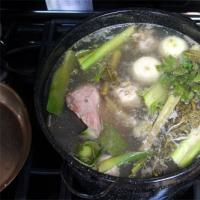White movement. The most famous generals of the white movement The origin of the white movement briefly
The beginning of the white movement - the arrested generals (Denikin, Alekseev, Kornilov) leave the city of Bykhov.
The German occupation put an end to the spread of Soviet power to new territories and contributed to the formation of bridgeheads on which counter-revolutionary forces could organize: the Don, the North Caucasus, etc. Under the new conditions, the white movement strengthened, receiving the support of wide sections of the population. It became widespread due to the influx of Cossacks and previously inert citizens.
The White movement gradually formed at the end of 1917 and the beginning of 1918 after the October Revolution and the Bolsheviks' dispersal of the Constituent Assembly, which was called upon to peacefully resolve the issue of the state structure of Russia after the February Revolution of 1917
The goals of the White movement were: the liberation of Russia from the Bolshevik dictatorship, the unity and territorial integrity of Russia, the convening of a new Constituent Assembly to determine the state structure of the country.
Contrary to popular belief, monarchists made up only a small part of the White movement. The White movement consisted of forces that were heterogeneous in their political composition, but united in the idea of rejection of Bolshevism. This was, for example, the Samara government, “Komuch”, in which representatives of left-wing parties played a large role.
The core of the White movement in southern Russia was the Volunteer Army, created under the leadership of generals Alekseev and Kornilov in Novocherkassk. The area of initial operations of the Volunteer Army was the Don Army Region and Kuban. After the death of General Kornilov during the siege of Yekaterinodar, command of the white forces passed to General Denikin. In June 1918, the 8,000-strong Volunteer Army began its second campaign against Kuban, which rebelled against the Bolsheviks. On August 17, they take Yekaterinodar, and by the end of August they completely clear the territory of the Kuban army from the Bolsheviks. In the winter of 1918-1919, Denikin’s troops established control over the North Caucasus, defeating and destroying the 90,000-strong 11th Red Army operating there.
Having repulsed the offensive of the Red Southern Front (100 thousand) in the Donbass and Manych in March-May, on May 17, 1919, the Armed Forces of the South of Russia (70 thousand) launched a counter-offensive. They broke through the front and, having inflicted a heavy defeat on units of the Red Army, by the end of June they captured Donbass, Crimea, Kharkov on June 24, Ekaterinoslav on June 27, and Tsaritsyn on June 30. On July 3, Denikin set his troops the task of capturing Moscow.
During the attack on Moscow in the summer and autumn of 1919, the 1st Corps of the Volunteer Army under the command of General. Kutepov took Kursk (September 20), Orel (October 13) and began moving towards Tula. October 6 parts of the general. Shkuro occupied Voronezh. Since the main provinces and industrial cities of central Russia were in the hands of the Reds, the latter had an advantage. Makhno, having broken through the White front in the Uman region, with his raid across Ukraine in October 1919, destroyed the rear of the AFSR and diverted significant forces of the Volunteer Army from the front. The offensive on Moscow failed and, under the pressure of superior forces of the Red Army, Denikin’s troops began to retreat to the south
On January 10, 1920, the Reds occupied Rostov-on-Don, a large center that opened the road to Kuban, and on March 17, 1920, Ekateri-Nodar. The Whites fought back to Novorossiysk, and from there crossed by sea to the Crimea. Denikin resigned and left Russia
By the beginning of 1920, Crimea turned out to be the last bastion of the White movement in southern Russia. The command of the army was taken by Gen. Wrangel. The size of Wrangel's army in mid-1920 was about 25 thousand people. In the summer of 1920, Wrangel's Russian army launched an offensive in Northern Tavria. In June, Melitopol was occupied. In August, an amphibious landing was undertaken on Kuban, under the command of General. S.G. Ulagaya, however, this operation ended in failure.
At the end of August 1920, the Red Army near Warsaw was defeated, and on October 12, 1920, the Poles signed a truce with the Bolsheviks, and Lenin’s government threw all its forces into the fight against the White Army. In addition to the main forces of the Red Army, the Bolsheviks managed to win over Makhno’s army, which also took part in the assault on Crimea.
To storm Crimea, the Reds pulled together huge forces (up to 200 thousand people versus 35 thousand for the Whites). The attack on Perekop began on November 7. Despite the gigantic superiority in manpower and weapons, the Red troops for several days could not break the defense of the defenders of the Crimea, and only after, having forded the shallow Chongar Strait, units of the Red Army and Makhno’s allied detachments entered the rear of the main positions of the Whites and on November 11, the Makhnovists Borbovich's cavalry corps was defeated near Karpova Balka, and the White defense was broken through. The Red Army broke into Crimea. Wrangel's army and many civilian refugees were evacuated to Constantinople on ships of the Black Sea Fleet.
Fight in the North-West
General Yudenich created the North-Western Army on the territory of Estonia to fight Soviet power, from 5.5 to 20 thousand soldiers and officers.
N.N. Yudenich tried to take Petrograd twice (in spring and autumn), but was unsuccessful each time. The spring offensive (5.5 thousand whites against 20 thousand reds) of the Northern Corps (from July 1, the North-Western Army) on Petrograd began on May 13, 1919. The Whites broke through the front near Narva and, by moving around Yamburg, forced the Reds to retreat. On May 15 they captured Gdov. Yamburg fell on May 17, and Pskov fell on May 25. By the beginning of June, the Whites reached the approaches to Luga and Gatchina, threatening Petrograd. But the Reds transferred reserves to Petrograd, increasing the size of their group operating against the North-Western Army to 40 thousand, and in mid-July launched a counteroffensive. During heavy fighting, they pushed back the small units of the North-Western Army beyond the Luga River, and on August 28 they captured Pskov.
Autumn offensive on Petrograd. On October 12, 1919, the North-Western Army (20 thousand against 40 thousand Reds) broke through the Soviet front near Yamburg and on October 20, 1919, taking Tsarskoe Selo, reached the suburbs of Petrograd. The Whites captured the Pulkovo Heights and, on the far left flank, broke into the outskirts of Ligovo, having no reserves and having received no support from Finland and Estonia, after ten days of fierce and unequal battles near Petrograd with the Red troops (the number of which had grown to 60 thousand people) North -The Western army was unable to capture the city. Finland and Estonia refused assistance because the leadership of the White Army never recognized the independence of these countries. On November 1, the retreat of the Northwestern White Army began.
By mid-November 1919, Yudenich's army retreated to Estonia with stubborn fighting. After the signing of the Tartu Peace Treaty between the RSFSR and Estonia, 15 thousand soldiers and officers of Yudenich’s North-Western Army, under the terms of this treaty, were first disarmed, and then 5 thousand of them were captured by the Estonian authorities and sent to concentration camps.
The military operations of the white armies were opened by the Eastern Front. The offensive of Kolchak’s troops, due to disagreements among the Entente, developed in 2 directions. On March 4, the Siberian Army went on the offensive, developing it in the direction of the Botkin plant and further to Vyatka. Votkinsk and Sarapul were occupied. On March 6, the Western Army began its offensive. It was opposed by the weakened 5th Soviet Army. On March 14, the Whites occupied Ufa. By mid-April, Bugulma, Belebey, Sterlitamak and Buguruslan fell. The Eastern Front was recognized as the main front. On April 28, 1919, the troops of the Southern Group launched a counteroffensive (until June 19). Liberation of previously lost territories, capture of the Urals (Ekaterinburg (July 14), Chelyabinsk (July 24)). Defeat of Kolchak's troops near Chelyabinsk By the beginning of 1920, Kolchak's troops were completely defeated, he was arrested and executed on February 7, 1920.
The white movement or “whites” is a politically heterogeneous force formed at the first stage of the Civil War. The main goals of the “whites” are the fight against the Bolsheviks.
The movement was made up of adherents of various political forces: socialists, monarchists, republicans. The “Whites” united around the idea of a great and indivisible Russia and existed simultaneously with other anti-Bolshevik forces.
Historians offer several versions of the origin of the term “White Movement”:
- During the French Revolution, white was chosen by monarchists who opposed the ideals of the revolution. This color symbolized the royal dynasty of France. The use of white reflected political views. Thus, researchers deduce the origin of the name from the ideals of the movement's members. There is an opinion that the Bolsheviks called all opponents of the revolutionary changes of 1917 “white,” although among them there were not only monarchists.
- The second version is that during the October Revolution, the former armbands were used by opponents of the revolution. It is believed that this is what gave the movement its name.
There are several versions of the time of birth of the White movement:
- Spring of 1917 - an opinion based on the memories of some eyewitnesses of the events. A. Denikin argued that the movement arose in response to the Mogilev Officers' Congress, where the slogan “Save the Fatherland!” was proclaimed. The main idea behind the birth of such a movement was the preservation of Russian statehood and the salvation of the army.
- Politician and historian P. Milyukov argued that the White movement consolidated in the summer of 1917 as an anti-Bolshevik front. Ideologically, the bulk of the movement are Cadets and Socialists. The Kornilov uprising in August 1917 is said to be the beginning of the active actions of the “Whites,” the leaders of which subsequently became the most famous figures in the White movement in the South of Russia.
The phenomenon of the White movement - it consolidated disparate, hostile political forces, the main idea of which was state-centrism.
The basis of the “whites” are officers of the Russian army, professional military men. Peasants, from whom some of the leaders of the movement came, occupied an important place among the White Guards. There were representatives of the clergy, bourgeoisie, Cossacks, and intelligentsia. The political backbone is the Cadets, monarchists.
Political goals of the “whites”:
- The destruction of the Bolsheviks, whose power the “whites” considered illegal and anarchic. The movement fought for the restoration of pre-revolutionary orders.
- The fight for indivisible Russia.
- Convening and starting the work of the People's Assembly, which should be based on the protection of statehood and universal suffrage.
- The fight for freedom of faith.
- Elimination of all economic problems, solution of the agrarian issue in favor of the people of Russia.
- Formation of active and active local authorities and granting them broad rights in self-government.
Historian S. Volkov notes that the ideology of the “whites” was, in general, moderate-monarchical. The researcher notes that the “whites” did not have a clear political program, but only defended their values. The emergence of the White Guard movement was a normal reaction to the chaos reigning in the state.
There was no consensus among the “whites” regarding the political structure of Russia. The movement planned to overthrow the criminal, in their opinion, Bolshevik regime and decide the future fate of statehood during the National Constituent Assembly.
Researchers note an evolution in the ideals of the “whites”: at the first stage of the struggle, they sought only to preserve the statehood and integrity of Russia; starting from the second stage, this desire turned into the idea of overthrowing all the achievements of the revolution.
In the occupied territories, the “whites” established a military dictatorship; within these state formations, the laws of pre-revolutionary times were in force with changes introduced by the Provisional Government. Some laws were adopted directly in the occupied territories. In foreign policy, the “whites” were guided by the idea of maintaining obligations to allied countries. First of all, this concerns the Entente countries.
Stages of “white” activity:
At the first stage (1917 - early 1918), the movement developed rapidly and managed to seize the strategic initiative. In 1917, social support and financing were still practically absent. Gradually, underground White Guard organizations were formed, the core of which were officers of the former tsarist army. This stage can be called the period of formation and formation of the structure of the movement and main ideas. The first phase was successful for the “whites”. The main reason is the high level of training of the army, while the “red” army was unprepared and scattered.
In 1918 there was a change in the balance of power. At the beginning of the stage, the “whites” received social support in the form of peasants who were not happy with the economic policies of the Bolsheviks. Some officer organizations began to come out of hiding. An example of a vivid anti-Bolshevik struggle was the uprising of the Czechoslovak Corps.
At the end of 1918 - beginning of 1919 - a time of active support for the “whites” by the Entente states. The military potential of the “whites” was gradually strengthened.
Since 1919, the “whites” have lost the support of foreign interventionists and are defeated by the Red Army. Military dictatorships founded earlier fell under the onslaught of the “reds”. The actions of the “whites” were not successful due to a complex of economic, political and social reasons. Since the 1920s, the term "whites" has been used to refer to emigrants.
Many political forces, consolidated around the idea of fighting Bolshevism, formed the White Movement, which became a serious opponent of the “red” revolutionaries.
The failure that befell the whites in 1918 led to the consolidation of communist power for approximately 70 years. That is why a person who considers himself Russian needs to know what reasons lay behind this. After all, as you know, those who know history usually do not repeat their mistakes. The white movement is not some isolated period in the history of Russia, as it is ingrained in the public consciousness. This is a big movement that is sweeping all of Europe. And if we are talking about Russia, then this in its essence is a great patriotic movement.
However, the purpose of this article is not to examine the moral significance of the White movement.
The white movement as an armed struggle against revolutionary movements originated in the south of our country and only then spread to its other regions. First of all, it began in Rostov-on-Don, where on November 15, 1917, General Alekseev raised the banner of protest. This front lasted day after day for three years. In the east, from November 1918 to February 7, 1920, Kolchak’s front operated (the fight lasted a year and 3 months). And for about 11 months there was a struggle on the western front of General Yudenich - from the end of 1918 to October 1919.
But why, having started so actively, did the white movement decline so quickly?
1. LACK OF UNITY AND TACTICAL ERRORS
If you look at the map of the civil war, then at first glance you might mistakenly think that the red spot of the Bolsheviks is surrounded by white fronts, which gives an advantage. In fact, the strategy of encirclement is successful only when the actions of the allies are coordinated and clear. But in our case there are many reservations. Firstly, the simultaneous existence of all fronts lasted less than a year. Secondly, all fronts for the most part acted autonomously, without the ability to interact with each other, since communication between them was almost always stopped by Bolshevik sabotage. Thirdly, there was no unified command and there was no physical ability to create it. One has only to remember that all attempts by General Denikin to get in touch with Kolchak, to whom he considered himself subordinate, ended in failure. 
And in such a situation you cannot talk about the environment. This situation allowed the Bolsheviks to use the “divide and conquer” tactics. Without giving the Whites the opportunity to join forces and having access to the reserves of the capital, they had a tactical advantage. Of course, the Whites made attempts to reverse this situation. So there were the ideas of moving “to the right” and uniting the eastern and southern fronts or the “left strategy” (moving through Ukraine), but none of them were fully realized.
What we see now is not much different from the situation in the past. The white movement is very fragmented and there is no unity among it. Moreover, despite all the goodness of the idea, most movements function more like an online publication that does not carry any specific goals.
Each of these directions, be it BARS or Sputnik and Pogrom, operate autonomously from each other. But the worst thing is that they don’t even try to agree on cooperation.
Of course, the new White movement in Russia is still very young. For 70 years it was practically absent, and if it existed, it was only outside the borders of the former USSR. And this can explain some of the immaturity and unwillingness to fully cooperate. But the mistake remains the same: until there is unity and a clear strategy among the whites, we will fail.
CONCLUSION ONE:
– the white movement needs a platform to unite its efforts. It is too early to talk about the merger of all the right into one movement. But a basis needs to be created.
2. LACK OF PROPER PROPAGANDA AND IDEOLOGY

During the civil war, the right was reproached for not proclaiming either a pro-monarchist or pro-republican ideology. Of course, to some extent this is due to the fact that it was not possible to prevent the crime of July 17, 1918 (the execution of the royal family).
Of course, a simple monarchist slogan would not correct the situation. He did not help either the Astrakhan army, which died near Tsaritsyn, or the Southern army of General Ivanov, or the Zemstvo army of Diederichs. But such a mistake had serious consequences. The Bolsheviks proposed a clear plan of action. The right - only vague promises.
It was unclear what exactly the whites wanted. What kind of political system should we establish? What kind of king do they want to put on the throne? Do they even want to?
The whites' clearly anti-populist policy regarding the war also played a negative role. At a time when the people are tired of its hardships, it is difficult to attract volunteers with slogans “for” the continuation of the war. The same applies to the overly open policy “for” preserving the unity of Russia. This position is undoubtedly correct. But in conditions when the Reds in their promises went to any lie in order to lure away supporters, this is obviously wrong.
As a result, this situation led to the Reds taking advantage of White's mistakes. The tempting slogans of the Bolsheviks, such as: “Rob the loot,” sounded much more attractive than the white ones, “For the Tsar.” But this was not what was scary, but the fact that whites were unable to resist the misinformation contained in these slogans. And therefore, the white army began to be associated with pogroms and robberies (a natural phenomenon for military operations, and the same Reds calmly resorted to this).
Now we see an even more depressing picture.
90% of the ideology of the white movement lies in the banal restoration of the monarchy of 1917, without any attempt to somehow impose this image on modern realities. After all, it is obvious that what was relevant at the beginning of the 20th century is very difficult to apply a century later. No modern monarchy exists in the same form as it did at the beginning of the First World War. The institutions of power and their functions have undergone changes. The new Russian monarchy should also be revised.
The current right-wing movements, just like in 1917, do not ask the question: why does a modern Russian need a monarchy and a tsar? What will an ordinary Russian person get from this? It is obvious that his material level will not rise immediately, and neither the political nor the economic crisis will disappear in the country. And if the political programs of the same “United Russia” or “LDPR” are primarily socially oriented, then the whites’ ideas are concentrated only around a change in the type of power. The remaining questions are either omitted or considered in a very condensed form.
A negative role was also played by the fact that over 70 years of communist power, the image of the Russian monarchy was leveled to “bast-foot Rus'”. Today, the average Russian citizen is unlikely to associate with the Russian Empire an exemplary legal system, a low (compared to the European powers of that time) level of corruption, the largest aviation fleet in the world, or colossal rates of industrial growth.
And we can say that this is one of the main problems of the modern monarchical movement. In people’s minds, the history of Russia is divided into two stages: Lapotno-Catherine’s and Soviet-nuclear. 
And what is the result of this? Today, on the wave of growing patriotic sentiment in the country, it would seem that the popularity of the right-wing movement should increase significantly. But instead, movements like National Bolshevism, National Anarchism and the like appear.
THUS, IT CAN BE SUMMARIZED THAT:
– there is no systematic propaganda. What we see are only isolated fragments
- lack of focus. It is not enough to simply revive the idea of the monarchy or evoke feelings of nostalgia for it
– the need to eradicate “odious” associations, such as: the monarchy with an outdated type of system, the white movement as the Nazis.
– the need for social orientation of white policy, and not just lobbying for a change in the type of power.
That is why propaganda, namely its creation in full, is the main task of the white movement.
3. Selfishness of allies

Any political movement is impossible without allies. However, you cannot trust them with everything. And this is precisely what was reproached by the whites by their contemporaries. General Denikin in his work calls the policy of the allied countries of the Entente “self-interested” and this is probably the best definition of the concept of “ally” in general. They cannot be considered traitors because they abandoned the whites and stopped providing them with any assistance, because after the peace in Brest they did not promise anything real to Russia, as such; and our Russian national interests in no way affect France or England. And they really were self-interested and did not go beyond their own interests. Everyone remembers well the “help” of the “allies” in the North: all support lasted only as long as the Entente felt the threat of the Germans and de facto, they used Russia as a threat to Germany in terms of restoring the second front. However, when such a threat disappeared “ Allies" left. But even as they left, they scuttled all the ammunition, supplies and equipment rather than handing them over to the Russians. After their departure, supplies to the Northern Front were literally carried out from the bottom of the sea. 
One cannot help but recall the role of the English fleet during the White offensive on Petrograd, when Russian forces were left on Krasnaya Gorka without any support. One can recall Odessa and Crimea, abandoned by the allies suddenly and in an absurdly fast 48-hour period. Thus, the conclusion arises that the Entente needed such support only to maintain confusion.
At the moment, this problem for whites is less acute than before. But only because it is more profitable for the same Western countries to support the Russian opposition than the still little-known Russian monarchist movement.
Thus, the Russian opposition is showing an active interest in new political movements with a view to cooperation. Including whites.
But as in the case of the Entente, this kind of “cooperation” should be treated with extreme caution, not only because our goals are radically opposite, but because the leading opposition forces would rather use the white movement for their own purposes and then apply Every effort is made to ensure that it remains secondary or disappears altogether, since they view us as their direct competitors.
For the same reasons mentioned above, one should be wary of reckless cooperation with the Orthodox world. We must not forget that the Russian Church is an independent force in the political arena, striving for its own benefits. We must not forget the fact that it is much more profitable for the church to turn the white movement into an amorphous movement, devoid of independence, with the sole purpose of spreading its goals through the idea of nationalism.
The whole essence of the Orthodox Church in the political process can be outlined by its extremely “self-interested” role, bordering on betrayal, in 1917, when a conspiracy was planned against Emperor Nicholas II. Based on the analysis of the documentary sources of that time available to us today, it is legitimate to conclude that the highest church hierarchs were indirectly involved in the conspiracy against the Emperor. It is reliably known about the negotiations that took place between a number of members of the Holy Synod and the Provisional Committee of the State Duma even before its overthrow. Is it necessary to explain that any contacts with this self-proclaimed body, which performed the functions of the headquarters of the anti-monarchist conspiracy, were a serious crime?
“The Provisional Government announced to us that it would grant the Orthodox Russian Church complete freedom in its governance, reserving only the right to stop decisions of the Holy Synod that are in any way inconsistent with the law and undesirable from a political point of view. The Holy Synod fully complied with these promises, issued a calming message to the Orthodox people and carried out other acts necessary, in the opinion of the Government, to calm minds.”
In conclusion, I would like to say that many more omissions could be listed, but for the most part these are the factors that influence all processes in Russia and are equally reflected in all political phenomena. Such a factor, for example, is the indifference of the Russian people to politics.
If you find an error, please highlight a piece of text and click Ctrl+Enter.
Every Russian knows that in the Civil War of 1917-1922 there were two movements – “red” and “white” – that opposed each other. But among historians there is still no consensus on where it began. Some believe that the reason was Krasnov's March on the Russian capital (October 25); others believe that the war began when, in the near future, the commander of the Volunteer Army Alekseev arrived on the Don (November 2); There is also an opinion that the war began with Miliukov proclaiming the “Declaration of the Volunteer Army”, delivering a speech at the ceremony called the Don (December 27). Another popular opinion, which is far from unfounded, is the opinion that the Civil War began immediately after the February Revolution, when the entire society was split into supporters and opponents of the Romanov monarchy.
"White" movement in Russia
Everyone knows that “whites” are adherents of the monarchy and the old order. Its beginnings were visible back in February 1917, when the monarchy was overthrown in Russia and a total restructuring of society began. The development of the “white” movement took place during the period when the Bolsheviks came to power and the formation of Soviet power. They represented a circle of people dissatisfied with the Soviet government, who disagreed with its policies and principles of its conduct.The “Whites” were fans of the old monarchical system, refused to accept the new socialist order, and adhered to the principles of traditional society. It is important to note that the “whites” were often radicals; they did not believe that it was possible to agree on anything with the “reds”; on the contrary, they had the opinion that no negotiations or concessions were acceptable.
The “Whites” chose the Romanov tricolor as their banner. The white movement was commanded by Admiral Denikin and Kolchak, one in the South, the other in the harsh regions of Siberia.
The historical event that became the impetus for the activation of the “whites” and the transition to their side of most of the former army of the Romanov Empire was the rebellion of General Kornilov, which, although suppressed, helped the “whites” strengthen their ranks, especially in the southern regions, where, under the leadership of the general Alekseev began to gather enormous resources and a powerful, disciplined army. Every day the army was replenished with new arrivals, it grew rapidly, developed, hardened, and trained.
Separately, it is necessary to say about the commanders of the White Guards (that was the name of the army created by the “white” movement). They were unusually talented commanders, prudent politicians, strategists, tacticians, subtle psychologists, and skillful speakers. The most famous were Lavr Kornilov, Anton Denikin, Alexander Kolchak, Pyotr Krasnov, Pyotr Wrangel, Nikolai Yudenich, Mikhail Alekseev. We can talk about each of them for a long time; their talent and services to the “white” movement can hardly be overestimated.
The White Guards won the war for a long time, and even let down their troops in Moscow. But the Bolshevik army grew stronger, and they were supported by a significant part of the Russian population, especially the poorest and most numerous strata - workers and peasants. In the end, the forces of the White Guards were smashed to smithereens. For some time they continued to operate abroad, but without success, the “white” movement ceased.
"Red" movement
Like the “Whites,” the “Reds” had many talented commanders and politicians in their ranks. Among them, it is important to note the most famous, namely: Leon Trotsky, Brusilov, Novitsky, Frunze. These military leaders showed themselves excellently in battles against the White Guards. Trotsky was the main founder of the Red Army, which acted as the decisive force in the confrontation between the “whites” and the “reds” in the Civil War. The ideological leader of the “red” movement was Vladimir Ilyich Lenin, known to every person. Lenin and his government were actively supported by the most massive sections of the population of the Russian State, namely the proletariat, the poor, land-poor and landless peasants, and the working intelligentsia. It was these classes that most quickly believed the tempting promises of the Bolsheviks, supported them and brought the “Reds” to power.The main party in the country became the Russian Social Democratic Labor Party of the Bolsheviks, which was later turned into a communist party. In essence, it was an association of intelligentsia, adherents of the socialist revolution, whose social base was the working classes.
It was not easy for the Bolsheviks to win the Civil War - they had not yet completely strengthened their power throughout the country, the forces of their fans were dispersed throughout the vast country, plus the national outskirts began a national liberation struggle. A lot of effort went into the war with the Ukrainian People's Republic, so the Red Army soldiers had to fight on several fronts during the Civil War.
Attacks by the White Guards could come from any direction on the horizon, because the White Guards surrounded the Red Army from all sides with four separate military formations. And despite all the difficulties, it was the “Reds” who won the war, mainly thanks to the broad social base of the Communist Party.
All representatives of the national outskirts united against the White Guards, and therefore they became forced allies of the Red Army in the Civil War. To attract residents of the national outskirts to their side, the Bolsheviks used loud slogans, such as the idea of a “united and indivisible Russia.”
The Bolshevik victory in the war was brought about by the support of the masses. The Soviet government played on the sense of duty and patriotism of Russian citizens. The White Guards themselves also added fuel to the fire, since their invasions were most often accompanied by mass robbery, looting, and violence in other forms, which could not in any way encourage people to support the “white” movement.
Results of the Civil War
As has already been said several times, victory in this fratricidal war went to the “reds”. The fratricidal civil war became a real tragedy for the Russian people. The material damage caused to the country by the war was estimated to be about 50 billion rubles - unimaginable money at that time, many times greater than the amount of Russia's external debt. Because of this, the level of industry decreased by 14%, and agriculture by 50%. According to various sources, human losses ranged from 12 to 15 million. Most of these people died from hunger, repression, and disease. During the hostilities, more than 800 thousand soldiers on both sides gave their lives. Also, during the Civil War, the balance of migration fell sharply - about 2 million Russians left the country and went abroad.
Anton Denikin
Anton Ivanovich Denikin was one of the main leaders of the White movement during the Civil War, its leader in the south of Russia. He achieved the greatest military and political results among all the leaders of the White movement. One of the main organizers, and then commander of the Volunteer Army. Commander-in-Chief of the Armed Forces of the South of Russia, Deputy Supreme Ruler and Supreme Commander-in-Chief of the Russian Army, Admiral Kolchak.
After the death of Kolchak, all-Russian power was supposed to pass to Denikin, but on April 4, 1920, he transferred command to General Wrangel and on the same day he left with his family for Europe. Denikin lived in England, Belgium, Hungary, and France, where he was engaged in literary activities. While remaining a staunch opponent of the Soviet system, he nevertheless refused German offers of cooperation. Soviet influence in Europe forced Denikin to move to the United States in 1945, where he continued to work on the autobiographical story “The Path of a Russian Officer,” but never finished it. General Anton Ivanovich Denikin died of a heart attack on August 8, 1947 at the University of Michigan Hospital in Ann Arbor and was buried in a cemetery in Detroit. In 2005, the ashes of General Denikin and his wife were transported to Moscow for burial in the Holy Don Monastery.
Alexander Kolchak

The leader of the White movement during the Civil War, Supreme Ruler of Russia Alexander Kolchak was born on November 16, 1874 in St. Petersburg. In November 1919, under the pressure of the Red Army, Kolchak left Omsk. In December, Kolchak’s train was blocked in Nizhneudinsk by the Czechoslovaks. On January 4, 1920, he transferred the entirety of the already mythical power to Denikin, and the command of the armed forces in the east to Semyonov. Kolchak's safety was guaranteed by the allied command. But after the transfer of power in Irkutsk to the Bolshevik Revolutionary Committee, Kolchak was also at his disposal. Upon learning of Kolchak's capture, Vladimir Ilyich Lenin gave orders to shoot him. Alexander Kolchak was shot along with the Chairman of the Council of Ministers Pepelyaev on the banks of the Ushakovka River. The corpses of those shot were lowered into an ice hole on the Angara.
Lavr Kornilov

Lavr Kornilov - Russian military leader, participant in the Civil War, one of the organizers and Commander-in-Chief of the Volunteer Army, leader of the White movement in the South of Russia.
On April 13, 1918, he was killed during the assault on Yekaterinodar by an enemy grenade. The coffin with Kornilov's body was secretly buried during the retreat through the German colony of Gnachbau. The grave was razed to the ground. Later, organized excavations discovered only the coffin with the body of Colonel Nezhentsev. In Kornilov’s dug up grave, only a piece of a pine coffin was found.
Peter Krasnov

Pyotr Nikolaevich Krasnov - general of the Russian Imperial Army, ataman of the All-Great Don Army, military and political figure, writer and publicist. During World War II, he served as head of the Main Directorate of Cossack Troops of the Imperial Ministry of Eastern Occupied Territories. In June 1917, he was appointed head of the 1st Kuban Cossack Division, in September - commander of the 3rd Cavalry Corps, promoted to lieutenant general. He was arrested during the Kornilov speech upon arrival in Pskov by the commissar of the Northern Front, but was then released. On May 16, 1918, Krasnov was elected ataman of the Don Cossacks. Having relied on Germany, relying on its support and not obeying A.I. To Denikin, who was still focused on the “allies,” he launched a fight against the Bolsheviks at the head of the Don Army.
The Military Collegium of the Supreme Court of the USSR announced the decision to execute Krasnov P.N., Krasnov S.N., Shkuro, Sultan-Girey Klych, von Pannwitz - for the fact that “they waged an armed struggle against the Soviet Union through the White Guard detachments they formed and carried out active espionage, sabotage and terrorist activities against the USSR.” On January 16, 1947, Krasnov and others were hanged in Lefortovo prison.
Peter Wrangel

Pyotr Nikolaevich Wrangel was a Russian military commander from the main leaders of the White movement during the Civil War. Commander-in-Chief of the Russian Army in Crimea and Poland. Lieutenant General of the General Staff. Knight of St. George. He received the nickname “Black Baron” for his traditional everyday dress - a black Cossack Circassian coat with gazyrs.
On April 25, 1928, he died suddenly in Brussels after suddenly contracting tuberculosis. According to his family, he was poisoned by the brother of his servant, who was a Bolshevik agent. He was buried in Brussels. Subsequently, Wrangel's ashes were transferred to Belgrade, where they were solemnly reburied on October 6, 1929 in the Russian Church of the Holy Trinity.
Nikolai Yudenich

Nikolai Yudenich - a Russian military leader, an infantry general - during the Civil War he led the forces operating against Soviet power in the northwestern direction.
He died in 1962 from pulmonary tuberculosis. He was buried first in the Lower Church in Cannes, but subsequently his coffin was transferred to Nice to the Cocade cemetery. On October 20, 2008, in the church fence near the altar of the Church of the Holy Cross Church in the village of Opole, Kingisepp district, Leningrad region, as a tribute to the memory of the fallen ranks of General Yudenich’s army, a monument to the soldiers of the North-Western Army was erected.
Mikhail Alekseev

Mikhail Alekseev was an active participant in the White movement during the Civil War. One of the creators, Supreme Leader of the Volunteer Army.
He died on October 8, 1918 from pneumonia and after a two-day farewell to thousands of people, he was buried in the Military Cathedral of the Kuban Cossack Army in Yekaterinodar. Among the wreaths laid on his grave, one attracted the attention of the public with its genuine touchingness. It was written on it: “They didn’t see, but they knew and loved.” During the retreat of the white troops at the beginning of 1920, his ashes were taken to Serbia by relatives and colleagues and reburied in Belgrade. During the years of communist rule, in order to avoid the destruction of the grave of the founder and leader of the “White Cause,” the slab on his grave was replaced with another, on which only two words were laconically written: “Mikhail the Warrior.”

 How to cook corn porridge in water according to a step-by-step recipe with photos
How to cook corn porridge in water according to a step-by-step recipe with photos The most delicious recipes for kefir biscuits
The most delicious recipes for kefir biscuits How to cook the most delicious cabbage - secrets Ukrainian cabbage with sauerkraut
How to cook the most delicious cabbage - secrets Ukrainian cabbage with sauerkraut Fortune telling with playing cards will allow you to find out everything that was hidden
Fortune telling with playing cards will allow you to find out everything that was hidden I dreamed that a bus overturned in a dream
I dreamed that a bus overturned in a dream Seeing large ripe pear fruits in a dream: meaning
Seeing large ripe pear fruits in a dream: meaning Why do you dream about Cooking?
Why do you dream about Cooking?